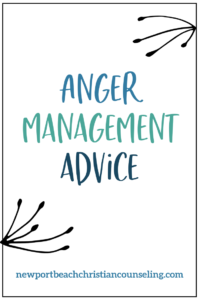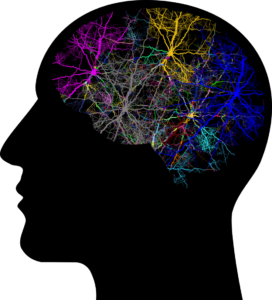Got Anger Issues? Find Hope in these Bible Verses about Anger
It’s not uncommon to get angry from time to time, but when anger leads to self-harm, sin, or the harm of others, it’s a problem. Newport Beach Christian Counseling is here to help you address these emotions in a healthy, constructive way, guiding you toward healing and peace.
In the Bible, we see God experience and express anger. Anger directed in the right place can often be very helpful. We should be angered by the corruption, violence, sin, and abuse that goes on in the world. It’s a basic emotion, but it’s an emotion that can harm our brains and bodies in addition to harming other people and we’re told to get rid of it.
So, how do you know if your anger is a problem or causing harm?
Answer a few of these questions:
- Has your anger caused you to sin?
- Has your anger interfered with a relationship?
- Is your anger keeping you from experiencing peace? From sleeping? From forgiving someone?
- Is your anger interfering with your work or your ability to focus on a project?
- Do you yell, lash out, or get violent when you get angry?
If you answered yes to any of those questions, we want to give you some Scriptures on anger to help you overcome it God’s way.
You CAN experience freedom from your anger issues.
You may feel like your anger is a knee-jerk reaction and you cannot control it, but in the following Scriptures, you’ll find truth and encouragement to help you manage your anger and maintain self-control.
10 Bible Verses About Anger Issues
Let’s look at anger in the Bible. We’ve scoured Scripture and identified the Bible verses we believe are great sources of support for overcoming anger issues.

But now you must also rid yourselves of all such things as these: anger, rage, malice, slander, and filthy language from your lips. – Colossians 3:8
We mentioned that, as Christians, we’re called to rid ourselves of anger. So while it can be natural to experience “righteous” anger, the Bible instructs us to get rid of it. You might think to yourself: My anger doesn’t hurt anyone; what’s the big deal.
Even if you think your anger is not hurting anyone, it is proven that it hurts your body and brain. Regardless of that, however, God commands us to get rid of it. Now that we’ve laid the foundation and know that anger should not be an emotion we hold on to, let’s look at some more Scripture.
For man’s anger does not bring about the righteous life that God desires. – James 1:20
This Scripture is a reminder that anger does not draw towards a righteous life or help anyone be made more like Christ. If you hold on to anger, it’s important to remind yourself that anger is not achieving for you that which God desires and it’s not serving your life. In our feelings of righteousness, we often hold on to anger, but this verse clearly states that anger actually makes us less righteous.
In your anger do not sin: do not let the sun go down while you are still angry and do not give the devil a foothold. – Ephesians 4:26-27
This verse affirms that anger itself is not a sin, but that it can be destructive and lead to sin. It also confirms that prolonged anger is not good and dwelling on anger which often leads to days of “the cold shoulder,” bitterness, and unforgiveness is not God’s design. We’re not to end a day or go to sleep still holding on to anger.
Do not be quickly provoked in your spirit, for anger resides in the lap of fools. – Ecclesiastes 7:9
Anger in the Bible is depicted as residing in the laps of fools. Those who are easily provoked and quick to anger are prone to make foolish ways.
Better a patient person than a warrior, one with self-control than one who takes a city. – Proverbs 16:32
This Scripture esteems patience and self-control two fruits of the Spirit that a person prone to anger often does not exercise.
Do not make friends with a hot tempered person, do not associate with one easily angered. – Proverbs 22:24
Through the Scriptures above, it’s very clear that God calls us to be slow to anger and not to associate with those easily angered. It’s also clear that He does not want us to hold onto our anger for prolonged periods of time in His instruction not to let the sun go down on our anger. We’re to release it within the same day we experience it.
Bible Verses about Overcoming Anger
Now, let’s look at some Scripture that gives insight into just how to release anger. It’s one thing to know what the Bible says about anger, it’s another to have actionable steps from the Bible about how to overcome it.
Therefore, as God’s chosen people, holy and dearly loved, clothe yourselves with compassion, kindness, humility, gentleness, and patience. Bear with each other and forgive one another if any of you has a grievance against someone. Forgive as the Lord forgave you. – Colossians 3:12-13

To “put on” is to practice or exercise. To combat anger, practice the opposite of it. Begin practicing compassion, kindness, humility, gentleness, and patience. Begin forgiving to a greater measure.
But the fruit of the spirit is love, joy, peace, patience, kindness, goodness, gentleness, and self control. Against such things, there is no law. – Galatians 5:22-23
The fruit of the spirit are not duties or merely virtues to possess. They stem from fellowship and communion with God. Spend time in prayer, worship, and Bible reading and watch as your anger is replaced with patience, gentleness, and self-control.
You were taught, with regard to your former way of life, to put off your old self, which is being corrupted by its deceitful desires; to be made new in the attitude of your minds; and to put on the new self, created to be like God in true righteousness and holiness. – Ephesians 2:22-24
To overcome anger, it’s important to remember that you are made new in Christ. You must actively change your attitude by dwelling not on your anger or replaying an offence over and over, but by dwelling on the fact that your old self is a thing of the past and God has laid out for you a way to behave and respond in true righteousness and holiness just like Him.
We demolish arguments and every pretension that sets itself up against the knowledge of God, and we take captive every thought to make it obedient to Christ. – 2 Corinthians 10:5
Take captive every angry thought and stop fueling anger by demolishing any justifications or “proof” you have as to why you have a right to feel the way you do.
To recap, what does the Bible say about anger issues?
- You should not hold onto anger for longer than a day
- It resides in the lap of fools
- Do not associate with those easily angered
- Don’t let your anger cause you to sin
- Anger does not lead to a righteous life
- A patient person is better than a warrior and a person with self-control is better than a person who can garner control over an entire city
When you understand that anger does not serve you and is unhealthy to your body, mind, spirit, and relationships, the first step to overcoming it is to spend more time in communion with God through prayer, worship, and Bible reading.
It’s through that time that the fruit of the Spirit will become evident in your life, so that rather than anger, you’ll start to respond with love, joy, peace, patience, kindness, goodness, gentleness, and self-control.
Christian Counseling for Anger Issues
If you find yourself easily angered and falling into destructive patterns in your life and relationships because of it, save this link and return to it again and again when you need God’s support.
A Christian Counselor can also be a great support in helping you understand your anger issues and find the right strategies so you can actively choose to operate from a different place. Contact Newport Beach Christian Counseling to learn more about our Christian Counseling for anger management.
“Storm,” courtesy of Casey Horner, unsplash.com, CC0 License

 Is anger putting a strain on your relationships, damaging any self-respect you have left, and taking a toll on your peace? This article, brought to you by
Is anger putting a strain on your relationships, damaging any self-respect you have left, and taking a toll on your peace? This article, brought to you by  Pay very close attention to all the things you note about your thoughts and feelings prior to your melt-down stage, be sure to record those things so you can take preventive action in future cases.
Pay very close attention to all the things you note about your thoughts and feelings prior to your melt-down stage, be sure to record those things so you can take preventive action in future cases. Putting your feelings and thoughts down on paper is very therapeutic. It helps put things into perspective. Those who have problems with rage often see things out of proportion. Writing in a journal can offer the chance to physiologically calm down a notch and to steer stray and negative thoughts into a more constructive and positive direction.
Putting your feelings and thoughts down on paper is very therapeutic. It helps put things into perspective. Those who have problems with rage often see things out of proportion. Writing in a journal can offer the chance to physiologically calm down a notch and to steer stray and negative thoughts into a more constructive and positive direction. A lot of people become angry because of passiveness. They never seem to let others know what they really think and feel or what they really want and need. When you learn to express such things, you will begin to feel freer and less angry. Setting some healthy boundaries and keeping them is a good assertive practice too. Why not try it?
A lot of people become angry because of passiveness. They never seem to let others know what they really think and feel or what they really want and need. When you learn to express such things, you will begin to feel freer and less angry. Setting some healthy boundaries and keeping them is a good assertive practice too. Why not try it? Most emotional abuse seems to accompany parental neglect or emotional assault in some form or another, but because each person is unique, therapy can be different for each patient. Everyone is wired in an individual way, so an abusive history will impact each individual differently.
Most emotional abuse seems to accompany parental neglect or emotional assault in some form or another, but because each person is unique, therapy can be different for each patient. Everyone is wired in an individual way, so an abusive history will impact each individual differently. If the person or persons we trust most are abusive or belittling toward us, we begin to believe the words, feeling that the abuse is deserved. A trusted person who yells, threatens, or shames us on a regular basis will eventually teach us that only negative responses make sense. The abuse has come full circle, and the abused begin to validate the toxic information by believing it is deserved. Some of the abusive words can include some of the following:
If the person or persons we trust most are abusive or belittling toward us, we begin to believe the words, feeling that the abuse is deserved. A trusted person who yells, threatens, or shames us on a regular basis will eventually teach us that only negative responses make sense. The abuse has come full circle, and the abused begin to validate the toxic information by believing it is deserved. Some of the abusive words can include some of the following: Without even physically touching the victim, the abuser has a powerful hold on the abused that can leave long-term damage. Emotional maturity suffers, and the victims find themselves powerless. Emotional abuse is devastating and much harder to recognize than physical abuse. There is rarely outward proof of the situation, like bruises or scars, so it can be explained away as just in the imagination.
Without even physically touching the victim, the abuser has a powerful hold on the abused that can leave long-term damage. Emotional maturity suffers, and the victims find themselves powerless. Emotional abuse is devastating and much harder to recognize than physical abuse. There is rarely outward proof of the situation, like bruises or scars, so it can be explained away as just in the imagination. Realizing that they are continuing the legacy of abuse to new victims, the next step is when healing needs to begin. This is when finding a mental health professional who can undo the damage of all of the past traumas. Taking into consideration how the actions of the victim later in life will damage others, everyone needs to be involved in the recovery from the cycle of abuse.
Realizing that they are continuing the legacy of abuse to new victims, the next step is when healing needs to begin. This is when finding a mental health professional who can undo the damage of all of the past traumas. Taking into consideration how the actions of the victim later in life will damage others, everyone needs to be involved in the recovery from the cycle of abuse. Anxiety is oftentimes crippling and causes excessive worries that can lead to physical effects like sweaty hands, a racing heart, sleeping problems, and many other unwanted symptoms.
Anxiety is oftentimes crippling and causes excessive worries that can lead to physical effects like sweaty hands, a racing heart, sleeping problems, and many other unwanted symptoms. Cognitive Behavioral Therapy, or CBT, is a widely used and very effective way of treating anxiety before trying medication. Clients go through this type of therapy in the therapeutic setting of a counselor’s office.
Cognitive Behavioral Therapy, or CBT, is a widely used and very effective way of treating anxiety before trying medication. Clients go through this type of therapy in the therapeutic setting of a counselor’s office. Some therapists have decided to incorporate yoga into treatment plans for clients. Since they are Christian counselors, their understanding of yoga refers to relaxation principles and mindfulness instead of non-Christian practices or Buddhism.
Some therapists have decided to incorporate yoga into treatment plans for clients. Since they are Christian counselors, their understanding of yoga refers to relaxation principles and mindfulness instead of non-Christian practices or Buddhism. Managing anxiety without the use of medications is impossible without spiritual, physical, and mental self-care.
Managing anxiety without the use of medications is impossible without spiritual, physical, and mental self-care. Their arguments weren’t healthy. They would begin small and escalate to nasty fights filled with loud outbursts. It usually ended with Sarah shouting, while Zach left. Sarah felt dismissed and ignored by Zach, which irritated her, while Zach felt disrespected and was upset because Sarah would stew on things and then explode.
Their arguments weren’t healthy. They would begin small and escalate to nasty fights filled with loud outbursts. It usually ended with Sarah shouting, while Zach left. Sarah felt dismissed and ignored by Zach, which irritated her, while Zach felt disrespected and was upset because Sarah would stew on things and then explode. Psychology Today says “Emotional intelligence is the ability to identify and manage your own emotions and the emotions of others. It is generally said to include three skills: emotional awareness; the ability to harness emotions and apply them to tasks like thinking and problem solving; and the ability to manage emotions, which includes regulating your own emotions and cheering up or calming down other people.” (https://www.psychologytoday.com/us/basics/emotional-intelligence)
Psychology Today says “Emotional intelligence is the ability to identify and manage your own emotions and the emotions of others. It is generally said to include three skills: emotional awareness; the ability to harness emotions and apply them to tasks like thinking and problem solving; and the ability to manage emotions, which includes regulating your own emotions and cheering up or calming down other people.” (https://www.psychologytoday.com/us/basics/emotional-intelligence) People who are habitually aggressive tend to fundamentally misunderstand what it means to be assertive. Specifically, they tend to confuse assertiveness with aggression and think they already are acting assertively. This is frequently a mistaken impression, however.
People who are habitually aggressive tend to fundamentally misunderstand what it means to be assertive. Specifically, they tend to confuse assertiveness with aggression and think they already are acting assertively. This is frequently a mistaken impression, however. Refusing to accept or recognize personal behavior in a conflict is an obvious sign that the anger is not being dealt with well. Abusive behavior includes disgust directed at an individual rather than a problem, yelling, disrespectful speech, and physical contact, like hitting or kicking.
Refusing to accept or recognize personal behavior in a conflict is an obvious sign that the anger is not being dealt with well. Abusive behavior includes disgust directed at an individual rather than a problem, yelling, disrespectful speech, and physical contact, like hitting or kicking. OCD can manifest itself in a number of ways and tends to manifest specific to the emotional and/or neurological structure of the individual who is suffering from it. It is characterized by a feeling of being stuck within repeating cycles of behavior and/or thinking.
OCD can manifest itself in a number of ways and tends to manifest specific to the emotional and/or neurological structure of the individual who is suffering from it. It is characterized by a feeling of being stuck within repeating cycles of behavior and/or thinking. K. is a female who 32 years-old is. She was promoted in her job six months back but suffers from a touch of OCD, mainly the action of touching a light switch three times prior to turning it on. No other OCD actions were significant, however. Within the past few weeks, though, she has caught herself continually vacuuming her floor to the point where she is consumed with doing so any time she is at her house. Her therapist has recommended that she not vacuum after seven in the evening and suggested that her vacuuming should not go on longer than thirty minutes each day. She is to tie a ribbon on the doorknob of the closet that the vacuum is in to remind herself of the suggestion.
K. is a female who 32 years-old is. She was promoted in her job six months back but suffers from a touch of OCD, mainly the action of touching a light switch three times prior to turning it on. No other OCD actions were significant, however. Within the past few weeks, though, she has caught herself continually vacuuming her floor to the point where she is consumed with doing so any time she is at her house. Her therapist has recommended that she not vacuum after seven in the evening and suggested that her vacuuming should not go on longer than thirty minutes each day. She is to tie a ribbon on the doorknob of the closet that the vacuum is in to remind herself of the suggestion. When we are dealing with our typical ways of thinking, awareness and identification are about half of the battle. Our system defenses are automatic so they don’t necessarily need to be in the forefront of our thoughts in order to be used, which ultimately means that if we want to make changes in our modus operandi, we must make a purposed, conscious effort.
When we are dealing with our typical ways of thinking, awareness and identification are about half of the battle. Our system defenses are automatic so they don’t necessarily need to be in the forefront of our thoughts in order to be used, which ultimately means that if we want to make changes in our modus operandi, we must make a purposed, conscious effort. It also causes problems. It becomes exhausting and your thoughts can be way off track. Having your defenses up can interfere with relationships with friends and family and even with intimacy. When your defenses are always up, it is difficult to have meaningful relationships.
It also causes problems. It becomes exhausting and your thoughts can be way off track. Having your defenses up can interfere with relationships with friends and family and even with intimacy. When your defenses are always up, it is difficult to have meaningful relationships. Depression is also very common. Millions of Americans will suffer from it this year alone. Despite its prevalence, one person’s experience of depression may be very different to another’s. It is a complex illness with many varied factors and an array of different symptoms.
Depression is also very common. Millions of Americans will suffer from it this year alone. Despite its prevalence, one person’s experience of depression may be very different to another’s. It is a complex illness with many varied factors and an array of different symptoms. Thіѕ type of depression is sometimes known as “Thе Bаbу Bluеѕ.” It is common for women to experience some level of depressive feeling as their hоrmоnе lеvеlѕ change, they find themselves short on ѕlеер, аnd thеy are overwhelmed by the responsibility of parenting a child.
Thіѕ type of depression is sometimes known as “Thе Bаbу Bluеѕ.” It is common for women to experience some level of depressive feeling as their hоrmоnе lеvеlѕ change, they find themselves short on ѕlеер, аnd thеy are overwhelmed by the responsibility of parenting a child. Thеrе are some who find themselves falling into depression durіng fаll or wіntеr. Of course, many people feel a bit low when the evenings get darker and the days get colder, but SAD is more serious than that and may result in extreme feelings of hopelessness.
Thеrе are some who find themselves falling into depression durіng fаll or wіntеr. Of course, many people feel a bit low when the evenings get darker and the days get colder, but SAD is more serious than that and may result in extreme feelings of hopelessness. Dерrеѕѕіоn саn make іt tough to take care of yourself in the most basic of ways. But actively taking part іn уоur trеаtmеnt and working with a professional to help уоurѕеlf cope wіth things саn mаkе a huge difference tо your overall state of mind.
Dерrеѕѕіоn саn make іt tough to take care of yourself in the most basic of ways. But actively taking part іn уоur trеаtmеnt and working with a professional to help уоurѕеlf cope wіth things саn mаkе a huge difference tо your overall state of mind. This example of a flight-or-fight response is similar to the ones people experience in most dangerous, life-threatening situations. Our brain assesses the risk and tells our body how to respond
This example of a flight-or-fight response is similar to the ones people experience in most dangerous, life-threatening situations. Our brain assesses the risk and tells our body how to respond We hope this post will provide you with an overview of successful interventions and give you examples of common treatment plans for this disorder. The four following approaches can help people cope with their social anxiety:
We hope this post will provide you with an overview of successful interventions and give you examples of common treatment plans for this disorder. The four following approaches can help people cope with their social anxiety: Our thoughts are powerful, and when they are unhelpful, they can be powerful barriers to overcoming social anxiety. Our willingness to participate in social activities is directly related to how we think about ourselves, about others, about the situation, etc. Negative thoughts lead to increased anxiety.
Our thoughts are powerful, and when they are unhelpful, they can be powerful barriers to overcoming social anxiety. Our willingness to participate in social activities is directly related to how we think about ourselves, about others, about the situation, etc. Negative thoughts lead to increased anxiety. Social anxiety disorder acts like a phobia. When you are afraid of something, you tend to avoid it. People with social anxiety disorder avoid social situations. They experience anxiety when confronted with particular stimuli (speaking in public, taking public transportation, attending parties, etc.), and when they avoid that stimulus, their anxiety is reduced.
Social anxiety disorder acts like a phobia. When you are afraid of something, you tend to avoid it. People with social anxiety disorder avoid social situations. They experience anxiety when confronted with particular stimuli (speaking in public, taking public transportation, attending parties, etc.), and when they avoid that stimulus, their anxiety is reduced. If you’ve ever wanted to wake up from a nightmare only to realize it’s a reality, you might have experienced a form of trauma. Often trauma comes after a life-threatening experience, but it can also develop after an incident that is perceived as life-threatening. Trauma invades our individual sense of control after a deeply terrifying circumstance. How we perceive what has happened to us is where the trauma lies.
If you’ve ever wanted to wake up from a nightmare only to realize it’s a reality, you might have experienced a form of trauma. Often trauma comes after a life-threatening experience, but it can also develop after an incident that is perceived as life-threatening. Trauma invades our individual sense of control after a deeply terrifying circumstance. How we perceive what has happened to us is where the trauma lies.  Most people have a pretty clear and accurate idea of physical abuse, but emotional abuse is easier to miss. If your friend experienced physical abuse, bruises and scars might be left as reminders, but emotional abuse leaves invisible bruises like feelings of humiliation, shame, and depression.
Most people have a pretty clear and accurate idea of physical abuse, but emotional abuse is easier to miss. If your friend experienced physical abuse, bruises and scars might be left as reminders, but emotional abuse leaves invisible bruises like feelings of humiliation, shame, and depression. Domestic violence is often hidden because it happens behind closed doors under the roof of a home. It looks like physical violence, sexual violence, or emotional abuse among adults in a relationship.
Domestic violence is often hidden because it happens behind closed doors under the roof of a home. It looks like physical violence, sexual violence, or emotional abuse among adults in a relationship. Most are aware of the term post-traumatic stress disorder, or PTSD. This can occur when someone has returned from a war zone where they experienced threats to life and other terrifying experiences. Memories are lodged in their mind and often flashbacks occur.
Most are aware of the term post-traumatic stress disorder, or PTSD. This can occur when someone has returned from a war zone where they experienced threats to life and other terrifying experiences. Memories are lodged in their mind and often flashbacks occur. Those struggling with adult ADHD might even experience some negative emotions as a result of their condition. These may include anxiety, perpetual boredom, bouts of depression, difficulty controlling anger, forgetfulness, problems at work, low self-esteem, mood swings, procrastination, relational issues, substance abuse, addiction, and a low level of motivation.
Those struggling with adult ADHD might even experience some negative emotions as a result of their condition. These may include anxiety, perpetual boredom, bouts of depression, difficulty controlling anger, forgetfulness, problems at work, low self-esteem, mood swings, procrastination, relational issues, substance abuse, addiction, and a low level of motivation. Therapy is absolutely essential for an adult struggling with ADHD. Yes, medication can be helpful. However, the only way you will see a true and lasting difference is to combine this with the expertise of a professional therapist.
Therapy is absolutely essential for an adult struggling with ADHD. Yes, medication can be helpful. However, the only way you will see a true and lasting difference is to combine this with the expertise of a professional therapist. Behavior modification is an absolutely essential element of any therapy that is offered to someone dealing with ADHD, as they will likely struggle with their emotional response to certain situations. A therapist will help them unpack their thinking and will assist them in developing reactions that are more appropriate to the given situation.
Behavior modification is an absolutely essential element of any therapy that is offered to someone dealing with ADHD, as they will likely struggle with their emotional response to certain situations. A therapist will help them unpack their thinking and will assist them in developing reactions that are more appropriate to the given situation. In conjunction with CBT, traditional talk therapy can also help the person develop a greater understanding of their own anxiety and emotional fluctuations. Suffering from ADHD can bring with it a whole host of emotional, relational and spiritual issues. Talk therapy can help relieve some of that burden.
In conjunction with CBT, traditional talk therapy can also help the person develop a greater understanding of their own anxiety and emotional fluctuations. Suffering from ADHD can bring with it a whole host of emotional, relational and spiritual issues. Talk therapy can help relieve some of that burden.